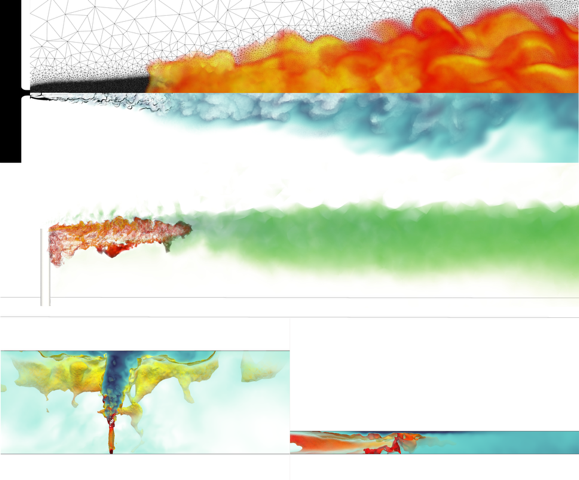🎓Lukas GAIPL Thesis Defense
Monday 29 September 2025 at 14h00
Phd Thesis JCA room, Cerfacs, Toulouse
LES of jet flames in crossflow with flame-wall interactions
MEGEP (Mécanique, Energétique, Génie civil & Procédés)
https://youtube.com/live/Z_mKDxI6W4k?feature=share

Jet flames are fundamental to many combustion systems, including turbines, industrial furnaces, rocket engines, and various safety-critical scenarios. Their interaction with environmental conditions such as crossflows and proximities significantly affects flame shape, stabilization, and heat transfer. This dissertation investigates jet flames in both open and confined configurations using advanced numerical simulations to improve predictive capabilities for turbulent, partially-premixed combustion. In the first part, new static mesh refinement strategies are developed to enhance resolution without requiring prior knowledge of the configuration, crucial for capturing physics in complex geometries. The methodology is applied to wake-stabilized jet flames in crossflow, revealing a complex flame topology with a premixed flame driven by air-entrainment and vortex dynamics, while excess fuel burns in a diffusion branch. The influence of thermal boundary conditions and reduced chemistry models on stabilization and efficiency is analysed, showing that increased heat losses at torch lips degrade stabilization and that strain sensitivity is critical to accurately predict fuel leakage. The second part addresses safety concerns associated with hydrogen use by exploring confined supersonic hydrogen jet flames in a channel with an air crossflow. This configuration mimics a flame stabilized on a leak of hydrogen in a duct. Varying tunnel height reveals that confinement controls flame stabilization: ducts higher than the flame lift-off height favour classical stabilization, while tighter confinement induces a diffusion-dominated regime with reduced fuel consumption. Comparable maximum wall heat loads are found in both cases, despite less hydrogen being burned in the narrow case. This is attributed to the different stabilization mode and confinement-induced dilution with cold gases, increasing temperature gradients near walls. These results highlight the critical role of flame stabilization subjected to heat losses and confinement in determining combustion efficiency and safety in next-generation energy systems.
Jury
| Prof. Dr. T. Schuller | CNRS – IMFT | President |
| Dr. P. Boivin | CNRS – M2P2 | Referee |
| Dr. B. Franzelli | CNRS – EM2C | Referee |
| Prof. Dr.-Ing. C. Hasse | TU Darmstadt | Examiner |
| Dr. G. Lartigue | CNRS – Coria | Invited Member |
| Dr. T. Poinsot | CNRS – IMFT | Advisor |
| Dr. T. Jaravel | CERFACS | Co-Advisor |
No content defined in the sidebar.

